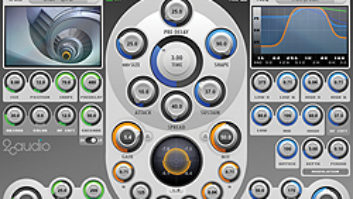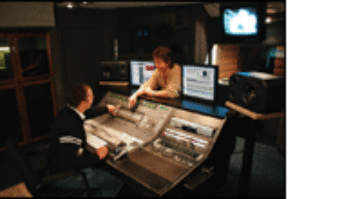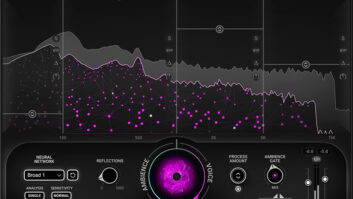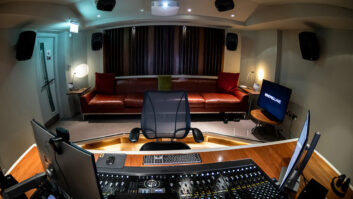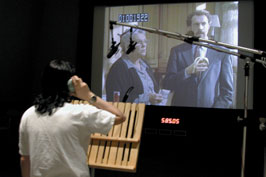

So far in our periodic in-depth series about the film sound chain, we’ve looked at production sound mixing (April 2004), sound effects recording (July 2005) and Foley recording (September 2005). This month, we examine the world of ADR — automated dialog replacement, also known as looping or dubbing (or post-synchronization in Britain). As most of you know, this is the critical procedure in which dialog is recorded in a studio for any number of reasons: to replace existing production sound that is not usable either for technical considerations (usually due to a noisy location) or editorial ones (lines of dialog have been changed); to add a voice-over to a film (often planned from the outset, but occasionally added at the last moment to help clarify a hazy plot); to add group voices not covered by production sound; to record dialog for an animated production; or to dub the film into another language. It is an exacting craft that requires great teamwork between the ADR team — usually a supervisor, who helps determine which lines need to be re-recorded, an ADR “mixer,” who actually runs the session, and some sort of tech assistant/recordist — and the actors.
We spoke with three of the best ADR mixers in Hollywood to get a sense of the scope of their job and how changes in technology are affecting what they do.
On the ADR soundstage at Fox in Los Angeles
MIXER BACK STORIES
Like so many people in film sound, Universal Studios Sound’s Jeff Gomillion was born into the business, so to speak. His father, Ted Gomillion, was a production sound mixer in the ’60s, a re-recording mixer in the ’70s and ran his own (now defunct) post facility in Hollywood: the Gomillion Theater, which opened in 1981 and was regarded as one of the most technologically advanced independent stages in Hollywood. “My dad hoped I’d go into the business, so he put me to work,” Jeff Gomillion says from the control room of ADR 4 in the Hitchcock Building on the Universal lot. “At first, I resisted a little bit. He wanted me to go to SC film school, but I spent so much time at his facility and got into the union at 18 as a projectionist, and shortly after that in the sound local [union]. I started off doing re-recording and I actually did ADR on those shows, as well; it was a small facility. I’d do the ADR and the Foley, and I mixed the effects and Foley on the final dub. I’d sit next to the dialog mixer and I learned a lot about what a dialog mixer needs to do to make ADR work. Most mixers come into the business and do ADR for a long time or Foley for a long time and then they go to re-recording, but I did it the other way.” Gomillion’s credits include dozens of features — As Good As It Gets, The Pink Panther, The Ring Two, The Chronicles of Riddick, The Cat in the Hat, The Scorpion King, The Fast and the Furious, Memento, Bram Stoker’s Dracula — and regular TV work, including Desperate Housewives and 24.
Film sound was also in Charleen Richards-Steeves’ blood: “My grandparents owned a couple of little non-union studios,” she says from her ADR room on the Fox lot. “My grandfather — Dale Knight — started doing production mixing at RKO. My cousin and my uncle also did production mixing, so I started working for them. I used to go out in the summers and help around there, but mostly I did their books, because at the time, women were not allowed in the union. Then the guy who was doing transfers disappeared, so I learned how to do that, in addition to typing up the bills and doing the books. After a while, it got real busy around town and [the studio] became a signatory with the union, and by then, they were letting women in the union — I was probably 23 or 24.” She soon gravitated to film sound jobs, beginning with Foley work and eventually settling in at ADR. Among her more than 150 credits (including 20 just in 2004 and 2005) are Munich, Fantastic Four, War of the Worlds, The Incredibles, Collateral, Shrek 2, The Last Samurai, Seabiscuit, Minority Report, Pearl Harbor, JFK, L.A. Confidential and Fight Club.
A guy with a name like Doc Kane should be a crusty 75-year-old who got his start with Orson Welles in the late ’40s. But actually, Kane has only been mixing ADR since the mid-’80s — still plenty of time to become a beloved and nearly legendary figure. An L.A. native, he first became interested in sound through music. “I played drums in a band in high school and college, and at one point, we borrowed all our dads’ tape recorders and overdubbed ourselves to sound like eight guys,” he says from the Disney lot, where he’s worked for the past 17 years. “I was not a very good drummer; I was actually better on the engineering side.
“But what affected me most is when I was in high school, we used to get out early on Fridays and go hang around down at Paramount — Paul Haggar was the head of the sound department and he would let us sit on the scoring stage. This is around 1972,” Kane continues. “When I got out of high school, I got a job working on a sound effects library. I didn’t know what film sound was until I worked for a guy named Richard Einfeld, who taught me about production sound using a Nagra and boom mics. We did a lot of police training films: I was the location mixer and did the lights — wearing all the hats. They were looking for sound people at another studio called Sound Services [SSI] and I learned how to record voice-over and cut commercials on quarter-inch. From there, I went to work for [director] Hal Ashby, who was putting together a sound-transfer and video-transfer company — he was one of the first directors to cut on video with the Betamax. Then I went to Warner Hollywood [Goldwyn], and from there over to Disney.” As you’d expect, Kane’s resume is peppered with scads of animated films — including Aladdin, Pochahontas, A Bug’s Life, Monsters Inc., The Incredibles, Chicken Little and Cars — but among his nearly 200 credits are scores of films of every variety, such as National Treasure, Ladder 49, The Village, Panic Room, Meet the Parents, Rush Hour, Good Will Hunting and Magnolia.
THE BIG PICTURE
Clearly, one of the thrills of working in ADR is the incredible variety of projects. “There’s no ‘typical’ film,” Kane says. “Sometimes it can be two days, sometimes it can be three weeks or a month. And it’s not constant. Sometimes we work on something for two days, and then don’t see them again for another few days. Sometimes we work all week or a day here, and then two weeks later it’s two days. It’s never the same. Every film is different. Every day is different. That’s what’s fun about it.”

Universal Studios Sound’s Jeff Gomillion
“When I first started doing this, a show would come in and it would be all cut and you’d work on it maybe a week and get everything done,” adds Richards-Steeves. “But these days, it’s more likely that the ADR is being done by several different people — now you’re just doing parts of it because schedules are weird and actors are all over the place, and now you have ISDN, so you might have an actor in New York or London and the director in L.A. So I’ll do some and Doc [Kane] will do some, Tommy [O’Connell] will do some. It’s gotten quite complicated. Working on several different things at once now is typical.”
“It depends on the director and the kind of film it is [whether there is a lot of ADR],” Gomillion says, “but in general, I’d say there’s less than there used to be. In the old days, they would loop hundreds of lines. Now on a feature, the typical amount might be just 30 or 40 lines on a sit-and-talky kind of movie.” One reason for that is production sound recording has become more reliable in recent years with the widespread adoption of RF microphones used in addition to traditional booms, as well as allowing more characters in a scene to be heard clearly regardless of the location.
IT ALL STARTS WITH THE MIC
The actual work of recording ADR has not changed that much through the years. It still involves recording actors in a studio, usually (but not always) working to picture. But within that job description, there is much variety and many layers of nuance. There is the delicate art of trying to match new dialog to existing production tracks, with all their ambience, differing sonic perspectives, etc. Mic selection and placement and understanding how the dialog fits in the scene are still perhaps the most critical components of the job.
“There are a lot of variables when it comes to mic choice,” Gomillion offers. “You want to know what they used on the set [to record the production track]. That helps get you in the ballpark. Is it the Sennheiser MKH Series and Neumanns? Or neither? Even though they use certain mics, when you get in a controlled environment with a lot of sound deadening [like an ADR studio], you might not be able to use the same mics because the coloration is different. I would say the Neumann KMR 81 and TLM have, for lack of a better word, the apparent coloration on them that makes them sound production-like. But lavs are very different, so it helps to know specifically what they used, and then we’ll go out and rent those or try to match them.”
“I used to use the Neumann U86s,” Richards-Steeves says, “but everything started to change when they went to digital recorders [instead of Nagras] on the set; those big, warm mics don’t work so well when you’re trying to match. Currently, I mostly use a Neumann KMR 81 and a Neumann 87, and a few different lav mics.”
Kane notes, “It usually comes down to a Sennheiser or a Schoeps [shotgun]. And now with radio mics, which have gotten better, the way we shoot ADR is we find out what the production mixer used and then if he shot on a [Zaxcom] Deva [digital recorder], he probably shot four channels, but we probably don’t need that because the other two channels are often background mics. So when we get it from the picture editors, it’s usually a combination of the lav and the boom, so we find out what they used on production and then we’ll shoot a lav and a boom to Pro Tools.
“When the shot changes, I change,” Kane continues. “If there’s a mic angle change and you can hear it, if we’re listening to the actor and the actor sounds a little close-miked, we’ll move the actor in or move the mic in. And if in the next shot you hear a little more ambience, we’ll have the actor move back so we can match all the mic angles.”
However, Richards-Steeves adds, “Sometimes dealing with tracks from these 4- and 8-track recorders [used by production sound mixers] makes it more complicated because they’re miking so many things, and unfortunately when we get the stuff, they’ve smashed things down and you’re getting more than one of the mics. It’s very different than when it was film and the editors would prepare a work track and you knew everything was at zero level. Now you wonder, ‘Is this what the actual production sounds like?’ because a lot of times it isn’t. Sometimes they take it into the editing room and they do little mini-mixes and they EQ, so you’re not really sure anymore what it sounded like [on the set] and what you’re supposed to match.”
IN THE EDITING ROOM
In the past few years, Pro Tools has become the de facto standard for recording and editing ADR. “Pro Tools has really revolutionized everything,” Gomillion says. “It not only makes the editor’s job easier, it makes my job easier because it’s often difficult for a client to imagine how a line’s going to work. But with Pro Tools, it makes presentation, as far as synching a line, very easy — right on the spot. In the old days, we’d have to take the single stripe down and go to the bench for 15 or 20 minutes. You do that now and the actor’s out the door! [Laughs] Now it just takes a few seconds and they can even do some other things with plug-ins and whatnot to give a better sense of how it will sound.

From left: Charleen Richards-Steeves with her engineer, Derek Casari, and recordist Dave Lucarelli
“I have an [Eventide] H3000 Harmonizer and I use the Sampler feature to capture a piece of background [from the production tracks], and then I’ll loop it behind [the newly recorded dialog] in Pro Tools on a separate track to help sell that the lines match across,” he continues. “Plus, if an actor is having trouble matching a line, it’s so easy to instantly play it back for them right there rather than having to cycle through the system and take another 30 or 40 seconds each time, like we had to do with tape. It speeds it up, they get a fresh read and we go right into record.”
Richards-Steeves adds, “You can try a lot of things you couldn’t try before, and you can adjust and move and do things like put a pause in or clip the end of a word so much more easily. The downside of that is that sometimes it can actually slow things down, because if you get a director who’s constantly asking to do things, you’re not just flowing along and letting the actor keep doing his thing.”
THE HUMAN FACTOR
This brings us to a delicate part of the job: working with actors. Now, no one is expecting ADR mixers to actually direct actors’ performances, but the fact is, they must be sensitive to their mood swings, make them as comfortable as they can and, above all, make sure that the recordings are as clean and present as possible.
“I think it would be good if all actors had to take a post-production history course because they don’t realize how good they have it now,” Gomillion says with a chuckle. “Even as recently as the early ’90s, if we had to loop only two or three lines in a scene, we would end up looping the whole scene. Now, with Pro Tools and being able to match things so that our playbacks and our presentation can sell the director and the actor that it’s going to work, things move so much faster.

The Walt Disney Studios’ Doc Kane
“Still, on our end, the most important thing you can do for an actor is to make them comfortable,” Gomillion continues. “And [at Universal] we have an outstanding craft service. You come into our ADR stages and they are like living rooms. A lot of actors come in and they don’t really like [doing ADR]. I’m behind the glass and my input is mostly technical: ‘Is the sound quality good for you?’ ‘Can you be perhaps a little louder?’ Usually, the sound supervisor will concentrate on the sync, and the director — or it might even be a picture editor or, in the case of a TV show, an associate producer — type — is really concerned about the performance, and my job is the sound quality. We cross over into each other’s worlds a little bit and help each other. It’s definitely a team.”
“You have to know when to say something and when not to,” adds Richards-Steeves, “because the most important thing is trying to make everything calm and peaceful and not have so much gab from the booth, unless you have to. The most important thing is to keep things moving transparently.”
What if an actor really can’t get a line down? “You have to be patient,” Kane says, “and if they’re really frustrated, we sample the line and put it in their ear and do a hear-it, say-it thing: We put the line in their headphone, we run the tapes wild and then we might do a series of 20 of them and then, if need be, we piece it together. We use an Eventide sampler for that, and now with Pro Tools, obviously you can use that, too.”
Some ADR mixers will deliver their files to the stage flat — with no EQ — so that the dialog editors and re-recording mixers can do what they need to do in cutting and, if necessary, treating the tracks. “Once it’s on the stage,” Richards-Steeves says, “they can EQ it or put reverb on it or effects or ‘world-ize’ it. They can do all those cool things that dubbing mixers have as their little tricks. At that point, we’re done with it.” Kane, however, says he’s constantly making small adjustments, trying to match the production sound’s EQ to the newly recorded ADR.
And, usually, the ADR mixers don’t know how the dialog they’ve gone to such pains to record will sound in the finished film. “I’m surprised all the time!” enthuses Kane. “I’m constantly amazed by it. The mixers on the stage have gotten so good they can take some pretty bad stuff and make it sound good, and they can take what we give them and make it sound like just about anything.”
Blair Jackson is Mix’s senior editor.

ON DOING ADR FOR ANIMATED FEATURES
Doc Kane: “It’s actually harder for the actors because it’s done so far in advance and they’re not working to picture. Usually, they’re just handed a sketch of what the character’s going to look like. The animation directors can give them their thoughts on where they think the character is going, but they still have to come up with their own original ideas and voice, and I don’t know how they do it.
“From our standpoint, with animated films we don’t have to worry about matching [production tracks], so we can use the mics we want. Normally, it stays to two microphones: a U87 and the Neumann TLM 170. If we get a little too esoteric and they end up having to grab the actor in Jamaica or some little funky town in the Midwest, 99 percent of the time they’re going to have a U87.”
ON DOING ADR FOR TV VS. FEATURES
Jeff Gomillion: “I have a little more license to do whatever I can to make it match in TV because it’s such a short time frame. For instance, if there’s a situation where a lav mic is employed, on a feature we’re going double-mike it with a lav and a boom, which would take a stereo track and twice as much space and twice as much cutting. On TV, we’ll do a take with the lav and say, ‘How did that work out?’ and they’ll say, ‘Great!’ and I’ll just go ahead and use that because the editor is so much up against it, time-wise, especially at the end of the season, when they’ve lost all of their pre-emptions with Olympics and so forth, and they’re jammed [with work] and a seven-day turnaround might be just a five-day turnaround. They just want it so the mixer can get [the ADR tracks] and make them work.”
Charleen Richards-Steeves: “A lot of times, when we’re doing TV it’s being shot [on the Fox lot] so it’s easy to bring the actors over. Sometimes it might be really quick—we only have them for 10 or 15 minutes. With TV, you don’t usually do as much as you do with a film. And that’s by design: Because of budgets and the fast turnaround, they don’t want to do a lot [of ADR]. You’re doing the same things, just less of it.
“One nice thing about doing a regular TV show is you get to know the characters and the voices of the actors and the things they do, and you can anticipate what they’re going to be like, whereas with a feature, each actor might be different in each feature.”
Gomillion: “After four or five episodes, you get into a rhythm where everything is really clicking because you have this give and take, and feedback. You talk to the mixer and see what works, learn what they need. You get into a rhythm and things fall into place more easily.”
ON THE CHALLENGES OF DIFFERENT KINDS OF FILMS
Richards-Steeves: “Sometimes the ‘talky’ movies are the hardest. Sometimes it’s a little trickier to get dialog to match and flow and get the right miking because you hear everything more clearly. A lot of times the action movies are pretty straightforward: They’re yelling and jumping, whatever, and you want to make sure you get enough volume to go over whatever loud backgrounds they’re going to have.”
Gomillion: “I’ve done movies where we’ve looped basically every line. [Francis Coppola’s] Dracula was like that. There were all these castle scenes and they re-did it for Foley because it was supposed to be marble floors on the set. Then he also played a lot of mood music on the set to get the actors in the mood, so all those scenes needed new dialog. And anytime the monster was there, they had the Ritter fans going and those were noisy.”
Kane: “When we did Hidalgo, we had to a do a lot of replacement because of the generators out in the desert. Generators, wind machines, hydraulics of any kind, loud motors: When those are used in a shoot, we know we’re going to be getting some work.”
Gomillion: “Sometimes it can be fun to do a really crazy movie, like Dawn of the Dead—that was so much fun because everyone comes in with lots of energy and they really get into it and we all know that’s it’s supposed to be over-the-top and not real. You know the voices are going to be pitched and distorted and that they’re going to be slobbering, so we just let ’em go crazy!”
